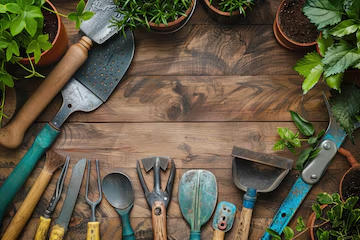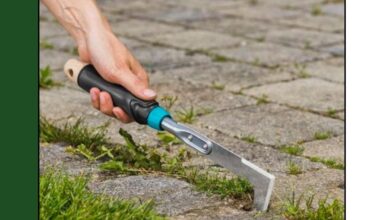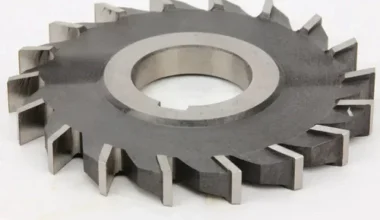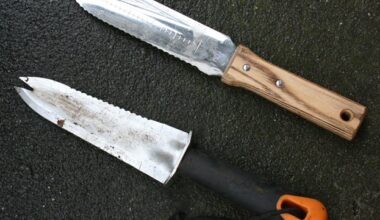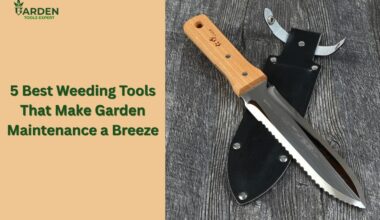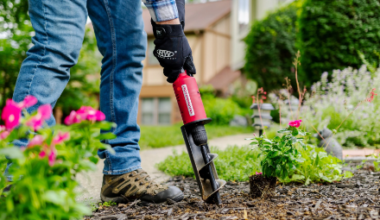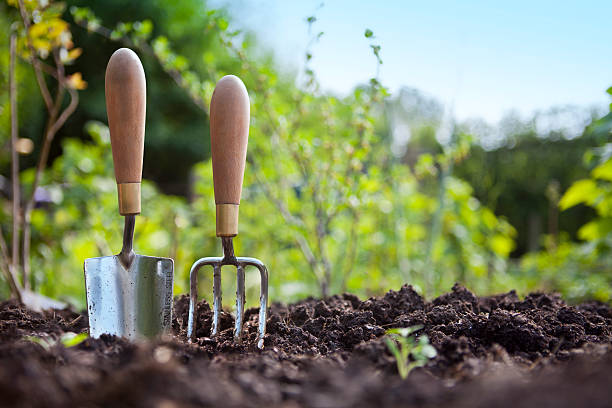
Table of Contents
The types of garden tools to be used in your backyard can be confusing. Do you really need ten different ones, or will just a few do the trick? For beginners, that question often feels overwhelming, but the answer is simpler than you think.
Gardening isn’t about having everything at once; it’s about starting small with the tools that truly make a difference.
Think about the excitement of planting your first seed and watching it sprout into something alive and thriving.
Now imagine how much easier and more rewarding that process feels when you have the right tools in hand a sturdy trowel that glides through the soil, shears that keep your plants healthy, or gloves that protect your hands as you work.
These little helpers aren’t just equipment; they’re part of the joy and rhythm of gardening itself.
In this post, we’ll explore five powerful types of garden tools every beginner gardener will love.
Each tool is simple, practical, and designed to take away the frustration while letting you focus on what really matters: watching your garden grow, one step at a time. By the end, you’ll know exactly which essentials to start with, and how they can turn gardening into a hobby you’ll fall in love with.
1. Hand Trowel – The Gardener’s Best Friend
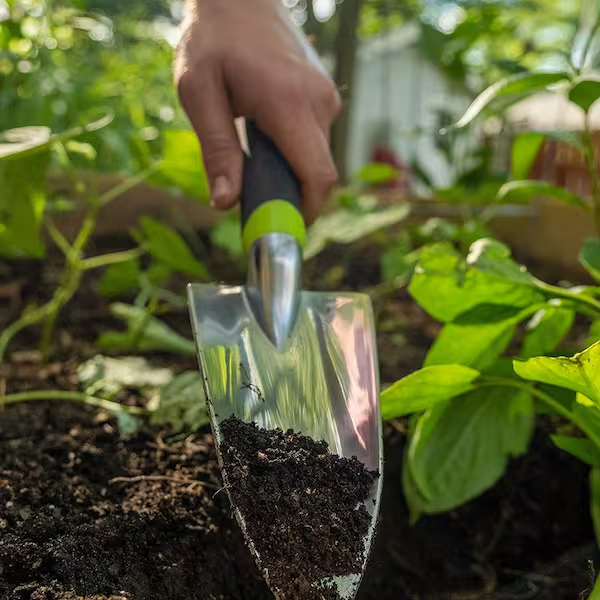
Among all the types of garden tools you’ll keep at home, the hand trowel is often the first one every beginner gardener falls in love with, and for good reason. Compact, versatile, and easy to handle, this small tool makes even the simplest gardening tasks smoother and more enjoyable.
Why It’s Essential
A hand trowel is perfect for those everyday jobs that don’t require large equipment. Whether you’re planting flowers, moving seedlings, or loosening soil in pots and beds, this tool gets the job done quickly.
It helps beginners learn proper planting techniques while reducing the strain of using bigger tools for smaller tasks.
Best Uses
- Planting seedlings and bulbs
- Digging small holes in garden beds or pots
- Transferring soil, compost, or fertilizer
- Removing weeds from tight spaces
Tips for Beginners
When choosing a hand trowel, look for one with a comfortable, non-slip grip. Stainless steel blades are recommended since they resist rust, stay sharp longer, and make digging into tough soil far easier.
2. Pruning Shears – Keeping Plants Neat and Healthy
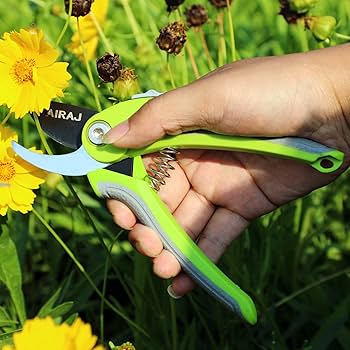
If you’re building your starter collection of types of garden tools at home, pruning shears should be near the top of your list. Also called hand pruners or secateurs, this tool is essential for keeping plants healthy, neat, and productive.
Why It’s Essential
Healthy plants grow stronger when old, damaged, or overgrown parts are removed. Pruning shears allow you to cut cleanly through stems and small branches, helping plants focus their energy on new growth.
Without them, you might end up breaking stems by hand or using the wrong tool, which can harm your plants.
Best Uses
- Trimming dead or damaged leaves and stems
- Shaping shrubs and small bushes
- Harvesting herbs, flowers, or vegetables
- Cutting back overgrowth to encourage fresh growth
Tips for Beginners
Choose pruning shears with sharp, high-quality blades for smooth cuts. Bypass pruners are often the best choice for beginners since they provide a precise cut without damaging tender stems.
3. Garden Hoe – Mastering Weeding and Soil Prep

When it comes to essential types of garden tools, the garden hoe is a true time-saver for beginners. Simple in design but powerful in use, this tool helps you manage two of the most common challenges in gardening: removing weeds and preparing soil.
Why It’s Essential
Weeds compete with your plants for water, nutrients, and sunlight. A garden hoe makes it easy to slice through weeds at the root, preventing them from taking over your beds. Beyond weeding, it’s also excellent for breaking up compacted soil and creating furrows for planting seeds.
Best Uses
- Removing weeds in garden beds and pathways
- Loosening and aerating soil before planting
- Creating straight furrows for seeds
- Mixing compost or fertilizer into the soil
Tips for Beginners
Beginners often find the stirrup hoe easiest to handle since it moves back and forth smoothly. Always choose one with a sturdy handle that matches your height to avoid bending too much.
4. Watering Can or Hose – Hydration Made Simple

No list of types of garden tools at home is complete without something to keep your plants hydrated. Whether you choose a traditional watering can or a garden hose, this tool ensures your plants get the consistent moisture they need to thrive.
Why It’s Essential
Water is the lifeline of your garden, but using the wrong method can lead to problems like root rot, uneven growth, or dried-out plants. A watering can gives you control over small spaces and delicate seedlings, while a hose is better for larger yards or raised beds.
Best Uses
- Watering seedlings, flowers, and potted plants
- Reaching wide areas in backyard gardens
- Providing gentle moisture with a spray nozzle
- Mixing liquid fertilizer into your watering routine
Tips for Beginners
If you’re starting small, invest in a lightweight watering can with a detachable rose head. For bigger gardens, a hose with an adjustable nozzle helps regulate water pressure and avoid plant damage.
5. Garden Gloves – Protecting Your Hands

While often overlooked, garden gloves are one of the most practical types of garden tools at home, especially for beginners. They may not dig or cut, but they protect your most important tool—your hands.
Why It’s Essential
Gardening without gloves can quickly lead to blisters, cuts, or even infections. A good pair shields you from scrapes while also providing a better grip when handling tools or pulling weeds.
Best Uses
- Pulling weeds and handling thorny plants
- Digging or planting in rough soil
- Carrying stones, mulch, or debris
- Protecting against pests or irritants in soil
Tips for Beginners
Choose gloves that fit snugly but allow finger movement. Breathable fabrics are great for hot weather, while durable, water-resistant gloves are ideal for tougher tasks. Keep an extra pair handy for light vs. heavy work.
Additional Types of Garden Tools Worth Considering
As you grow more comfortable with your garden routine, there are a few bonus types of garden tools you can keep at home to make your work easier and more enjoyable. These aren’t must-haves for beginner gardeners, but they’re smart upgrades once you’re ready to take the next step.
- Wheelbarrow – Among the most practical types of garden tools, a wheelbarrow saves time and energy when moving soil, compost, or heavy pots, especially if you’re expanding your backyard garden.
- Garden Fork – This versatile tool belongs to the essential types of garden tools for improving soil structure. It’s perfect for loosening compact soil, aerating beds, or turning compost to help your plants thrive.
- Kneeling Pad – While simple, a kneeling pad is one of those overlooked types of garden tools that can transform long planting or weeding sessions into a more comfortable experience by protecting your knees.
Adding these tools over time will enhance your gardening experience without overwhelming your toolkit.
Tips for Choosing the Right Garden Tools
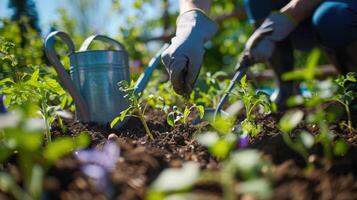
1. Start with Quality Over Quantity
As a beginner, it’s tempting to buy every tool you see, but the truth is, you only need a few essentials.
Focus on investing in quality gardening tools at home that will last longer and perform better.
A strong spade or durable pruning shears can save you money in the long run compared to replacing cheap, flimsy versions every season.
2. Test the Grip and Weight Before Buying
Comfort matters more than you might think. When choosing gardening tools at home, pick up the tool and check how it feels in your hand.
A lightweight tool with a comfortable grip reduces strain and makes gardening enjoyable instead of exhausting. If possible, visit a store to test the balance and handle before purchasing.
3. Maintain Your Tools Properly
Even the best tools won’t last if they’re not cared for. After each use, wipe off dirt and moisture to prevent rust.
Sharpen blades on pruning shears and hoes regularly so they cut efficiently. For beginner gardeners, keeping gardening tools at home clean and stored in a dry space will extend their life and ensure they’re ready whenever you need them.
4. Buy Tools That Match Your Garden Size
Consider your space before shopping. A small raised bed doesn’t require oversized rakes or long-handled hoes.
On the other hand, if you’re working with a larger backyard, sturdy tools designed for bigger jobs will make the work easier. Matching tools to your garden keeps your setup simple and effective.
Conclusion: Start Your Gardening Journey the Right Way
With just a handful of essential tools, gardening doesn’t have to feel overwhelming. These powerful types of garden tools are all you need to plant, prune, and nurture your backyard with confidence.
Whether it’s a simple trowel, a pair of pruning shears, or gloves that protect your hands, each tool is an investment in making your gardening experience smoother and more enjoyable.
Now it’s your turn to take action! Start small, choose wisely, and watch your garden come alive. If you found this guide helpful, don’t keep it to yourself
share it with friends who are also starting their gardening journey. Have a favorite tool you can’t live without? Drop a comment below and join the conversation with fellow beginner gardeners. Never miss a chance to grow smarter.
FAQs About Gardening Tools at Home
Q1: What are the most important types of garden tools for beginners?
The essentials include a hand trowel, pruning shears, spade, garden hoe, watering can or hose, gloves, and a rake. These basic gardening tools at home cover almost every beginner task.
Q2: Do I really need all seven types of garden tools at home to start gardening?
Not at once. Start with the ones you’ll use most, like a trowel, gloves, and watering can. You can add more tools as your garden grows.
Q3: How do I choose the right gardening tools at home?
Go for quality over quantity, test the grip and weight for comfort, and pick tools that match your garden size.
Q4: How should I care for my gardening tools at home?
Keep them clean, dry, and sharp. Store them in a dry space to prevent rust and extend their life.
Q5: Can the same gardening tools at home work for both vegetables and flowers?
Yes! Most essential tools are versatile. Just make sure to clean them between uses to avoid spreading pests or diseases.
Q6: What’s the biggest mistake beginners make with garden tools?
Buying too many at once. Start simple with a few reliable gardening tools at home and upgrade as you gain experience.

